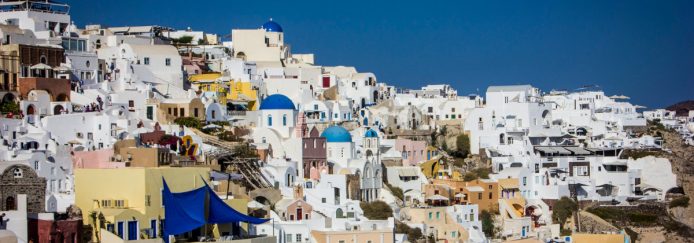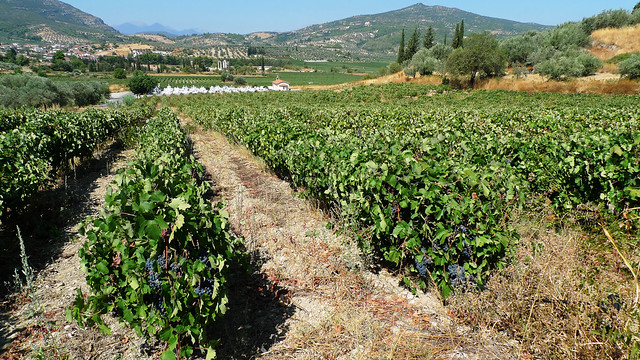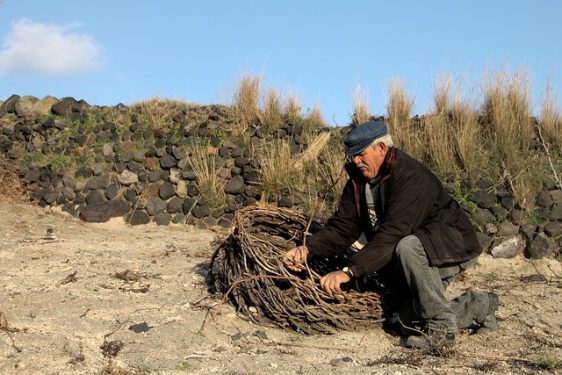Your Mini Basket

Greek wine: The best of the 'old' new world.
The most exciting wine region in the world? Might just be Greece...
The eastern Mediterranean is often seen as a slightly strange chimaera of a wine region, both old and new world in the same breath. Winemaking likely originated just slightly further north in Georgia, with Greece not that far behind. And yet, the average wine drinker’s exposure to the Med starts and ends at Retsina. Greece, and the whole region now produce some of the best wine in the world. Here, we take a look at some of the best Greek wine we could get our hands on.
Macedonia
There's no better example of Greek winemaking coming full circle than a winemaker like Vangelis Gerovassiliou. Greek wine was in the doldrums. In the 70s and 80s, a handful of winemakers began to spread their wings and study around the world before returning home to reinvigorate the local wine scene. For Vangelis, this meant earning his diploma at the renowned University of Bordeaux under Professor Emile Peynaud, who is regarded as one of the world's most important oenologists in history. On his return to Greece in 1976, he worked with his mentor Professor Vassilis Logothetis. Together, they rediscovered the forgotten grapes of Malagouzia and Limnio, both of which are now ever-present in Vangelis' winemaking.
In the early 80s, he began to restore the family vineyards at Epanomi in the far north of the country. The remarkable modern winery now standing there is the base for the Gerovassiliou estate wines, of which we're proud to be stockists. This is without a doubt some of the best Greek wine around.
Ktima Gerovassiliou Epanomi Viognier 2017, Macedonia, Greece
Viognier doesn't always take to oak ageing. Its fresh stone fruit aroma can quickly be muted by all the vanilla and spice. But the best examples, particularly from Condrieu in the northern Rhone region of France, have the intensity to carry the treatment. It turns out northern Greece can do it too. Silky textured with the beautiful, peachy perfume that Viognier has at its best.
Ktima Gerovassiliou Estate White 2017, Macedonia, Greece
A blend of Santorini's native Assyrtiko (see below) and Malagouzia, as re-pioneered by Vangelis Gerovassiliou. The high acid Assyrtiko dovetails wonderfully with the more textural, exotically musky aromas of Malagouzia. We find it hard to imagine a better wine to pair flexibly with the vast cornucopia of Greek cuisine. We'd be particularly interested to see how hardened Sauvignon Blanc drinkers took to this...
Ktima Gerovassiliou Avaton 2013, Macedonia, Greece
40% Limnio, another of Vangelis' rediscovered grapes, along with two other native reds, Mavrotragano and Mavroudi. This is Bordeaux in a hot vintage, picked up and transplanted in northern Greece. Deliciously ripe but perfectly balanced, with a freshness that seems to be characteristic of the region.
To The South

At the other end of the Greek mainland, southwest of Athens, lies the Peloponnese peninsula. It's an area famed for a variety of wines, not least my own guilty pleasure, the sweet red and fortified Mavrodaphne of Patras. But to the south of the peninsula, in the Nemea PDO (Protected Designation of Origin), you'll find seriously age-worthy, complex reds. These are often made from the local Agiorgitiko grape which is nicknamed 'Blood of Hercules', supposedly because this was the wine consumed in victory after the legend defeated the Nemean Lion.
Bizios Estate Nemea Single Vineyard Agiorgitiko 2011, Peloponnese, Greece
Ours comes from the Bizios Estate, from vines situated at 900 metres above sea level. The winters here are cold, snowy and wet, contributing more than enough rainfall to last through the year. The altitude and coastal influence mean that summer temperatures stick around 30C, with a healthy breeze off the sea to cool the vines at night. As Greek wine from this far south goes, this is pretty fresh, and yet the grape shines through. There's a plushness to this wine, the ripe jammy strawberry Agiorgitiko fruit at its core. The long bottle ageing has allowed the wine to settle, with the subtle spice of oak melding nicely with the more mature stewed fruit notes.
A number of winemakers are drawn to the idea of making Bordeaux-style wines in their own native climes. Medium to full bodied, food-friendly levels of tannins, balancing fruit and savoury notes through sensible use of oak. Very often these alternative regions can produce similar wines at a fraction of the cost, and so it is here. For just over £20, this is mature and very much Bordeaux-esque.
A wine as good as this from France could be easily twice the price, not to mention that finding reliable, good value, mature Bordeaux in retail is an unnecessarily stressful challenge. Don't be surprised if you see more and more of these kinds of wines on our shelves.
Island Hopping
Moving eastwards, to Santorini, in the Aegean sea, the home of the wonderful Assyrtiko grape. Santorini is the site of a dormant volcano and the soils on the island are evidence. A mix of ash and rock, volcanic soils always seem to have a remarkable effect on grapevines. (Just look to Tenerife, Sicily's Mount Etna and Itata in Chile for proof). Here on Santorini, they also seem to be helping the vines to resist disease and pests. Many of the vines here are original, pre-Phylloxera. Most of the world's grapevines have to be grafted onto rootstocks that are resistant to the small louse that has caused so much damage to the global wine trade. It's a similar story on other islands, where simple isolation must have a part to play.

Rainfall is minimal on Santorini, so steps are taken to capture any moisture possible. This is partly the reason for the unique 'Kouloura' vine training system. In order to capture as much of the night-time humidity in the air as possible, the self-rooted vines are trained low to the ground in a basket shape.
This nourishes the vines just enough to produce a healthy crop of intense, sweet grapes. The island is also particularly exposed, so the bunches are trained towards the insides of the basket, to protect them from vicious winds.
The grape itself is characterised by its super-high acidity. There are few grapes like it. Riesling is perhaps the closest parallel, and Assyrtiko is well-suited to ageing in the same way, taking on beautiful blossom honey notes with time. Even with full ripeness and bottle age, the acidity doesn't wane, so it really does need food. The pairings are countless, but it feels like all that brightness demands some fat for it to cut through. Maybe cured fish. Anyway, I digress...
Gaia Thalassitis Assyrtiko 2016, Santorini, Greece
Gaia is a big name in Greek wine, based both on Santorini and in Nemea, but their calling card is surely their quality Assyrtiko from the former. The winery is a former tomato factory; a stone industrial building on the east of the island. The long-ripening and natural acidity inevitably lead to a very well-balanced wine, with fierce minerality and citrus and floral notes. In so much as you can call any Santorini Assyrtiko conventional, this is slightly more so than Gaia's wild fermented version, but every bit as delicious.
Header image: Dafydd Vaughan, www.flickr.com, (CC BY-SA 2.0)




